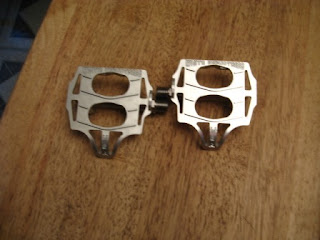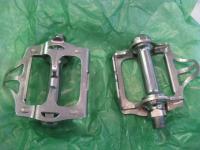Shakespeare never had an original idea--for a story, anyway--in his life. George Orwell took almost everything that makes 1984 worthwhile--including the notions of "thought crimes," "Big Brother" and its mathematical theme--from We, a novel from a little-known Russian writer named Yevgeny Zamyatin. (Orwell reviewed the book three years before 1984 came out.) D'Artagnan was not the creation of Alexandre Dumas; rather, Dumas lifted him--and Athos, Porthos and Aramis--from the first volume of Gaeten Courtilz de Sandras' book called The Memoirs of D'Artagnan.
In the book of Ecclesiastes, we find this: "There is nothing new under the sun." So it is in the world of literature and the arts. So it is in science and technology. And so it is in the world of bicycling. In the four decades I have been cycling, almost every "new" idea had been done before, sometimes in the very early history of cycling. As I mentioned in two recent posts, suspension is one such idea. Another idea is that of building frames of anything besides steel: During my formative years, carbon, titanium and aluminum frames were not only created; they were available to the general public (for a price, of course).
Then there are those ideas that never really go away but are nonetheless "rediscovered" by a new generation of marketing types (or, sometimes, actual cyclists who haven't been in the sport for very long). One such concept is that of the recumbent bicycle.
I am not about to dismiss recumbents, as I have never ridden one myself. I don't doubt that, as their proponents claim, their aerodynamics can make them faster than standard bicycles. My concerns about them are twofold: How well and comfortably can a rider use his or her muscles in such a position? (At my age, the answer to such questions is more meaningful than it was when I was younger!) And, how visible is a recumbent rider in traffic?
(I'll admit that the second question is the one that has done more to keep me off a recumbent!)
That there were recumbents before Dan Henry and others were touting them doesn't surprise me. It's also not surprising to note that in the years just after World War I, some cyclists experimented with riding nearly prone. Marcel Berthet--for whom the Lyotard No. 23 platform pedal was named--was concerned with aerodynamics, as were other racers and designers who flew or worked with aircraft during the war.
But it's truly interesting, if not shocking, to see that some two decades earlier, in 1896 a horizontal bicyclette normale was exhibited in Geneva. The Challand recumbent, named for its inventor, was said to allow easier mounting, improved stability and greater thrust on the pedals. It had just one problem, though: It weighed about three times as much as its rider!
Berthet and others who revived recumbents after the War used them in record attempts. Charles Mochet designed his own recumbent--dubbed the "Velocar"--and used it to set records for the kilometer, mile and hour. In the case of the latter, he broke a 20-year-old record by half a kilometer.
His exploits ignited a debate as to whether the "Velocar" was actually a bicycle. The Union Cycliste Internationale (UCI) answered that question in the negative, and banned recumbents, as well as aerodynamic devices, from racing in 1934. The UCI then declared all of Mochet's records invalid.
Given all of the controversy about pharmaceutical and mechanical doping, the controversy over recumbents seems almost quaint now. Recumbents are, I believe, here to stay, just as--unfortunately--doping is.
In the book of Ecclesiastes, we find this: "There is nothing new under the sun." So it is in the world of literature and the arts. So it is in science and technology. And so it is in the world of bicycling. In the four decades I have been cycling, almost every "new" idea had been done before, sometimes in the very early history of cycling. As I mentioned in two recent posts, suspension is one such idea. Another idea is that of building frames of anything besides steel: During my formative years, carbon, titanium and aluminum frames were not only created; they were available to the general public (for a price, of course).
Then there are those ideas that never really go away but are nonetheless "rediscovered" by a new generation of marketing types (or, sometimes, actual cyclists who haven't been in the sport for very long). One such concept is that of the recumbent bicycle.
I am not about to dismiss recumbents, as I have never ridden one myself. I don't doubt that, as their proponents claim, their aerodynamics can make them faster than standard bicycles. My concerns about them are twofold: How well and comfortably can a rider use his or her muscles in such a position? (At my age, the answer to such questions is more meaningful than it was when I was younger!) And, how visible is a recumbent rider in traffic?
(I'll admit that the second question is the one that has done more to keep me off a recumbent!)
That there were recumbents before Dan Henry and others were touting them doesn't surprise me. It's also not surprising to note that in the years just after World War I, some cyclists experimented with riding nearly prone. Marcel Berthet--for whom the Lyotard No. 23 platform pedal was named--was concerned with aerodynamics, as were other racers and designers who flew or worked with aircraft during the war.
 |
| The Challand Recumbent |
But it's truly interesting, if not shocking, to see that some two decades earlier, in 1896 a horizontal bicyclette normale was exhibited in Geneva. The Challand recumbent, named for its inventor, was said to allow easier mounting, improved stability and greater thrust on the pedals. It had just one problem, though: It weighed about three times as much as its rider!
Berthet and others who revived recumbents after the War used them in record attempts. Charles Mochet designed his own recumbent--dubbed the "Velocar"--and used it to set records for the kilometer, mile and hour. In the case of the latter, he broke a 20-year-old record by half a kilometer.
His exploits ignited a debate as to whether the "Velocar" was actually a bicycle. The Union Cycliste Internationale (UCI) answered that question in the negative, and banned recumbents, as well as aerodynamic devices, from racing in 1934. The UCI then declared all of Mochet's records invalid.
Given all of the controversy about pharmaceutical and mechanical doping, the controversy over recumbents seems almost quaint now. Recumbents are, I believe, here to stay, just as--unfortunately--doping is.







